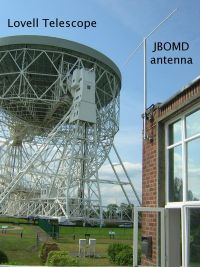Jodrell Bank Observatory's Meteor Detector

An example five-minute plot from 2009. Note that the time stamp on the plot is given in UT. Please see the highlights page for some interesting results.
Note: the JBOMD system was decommissioned in 2012 when European television switched to digital transmission. The images no longer update.
One of the first experiments carried out by physicists at Jodrell Bank in 1945 was the detection of echoes from meteors by the reflection of radio waves. Lovell and his colleagues used ex-Army radar equipment working at a wavelength of about 4-m to detect the reflections from the ionised trails left over in the upper atmosphere by these little particles of rock.
The current meteor detector was constructed in April 2007. Originally it picked up reflections from a television transmitter in Spain (transmitting at 48.25 MHz), far enough away that normally we can't receive the signal at all. When one of these ionised trails is created in the upper atmosphere, it can reflect the signal in our direction and we hear an echo. This transmitter went offline in 2010 as part of the European switch to digital TV. The system is currently tuned to another transmitter operating on 55.25 MHz, although neither the antenna or the filter are currently optimised for this frequency.
We have an antenna on the roof, connected to an amplifier and filter. The signal then goes down to a receiver in the cellar where it is converted to audio and fed into the soundcard of a computer which produces the plots. The plots have time along the bottom, the most recent event is on the right, and frequency up the side. Each bright spot you can see is a radio meteor detection.
The image on the left shows the antenna, in the background you can see the Lovell telescope. The building is the corner of the control room, and the antenna is the silver-looking T bolted to the brickwork near the roof. The cables run down into the cellar (passing the signal through an amplifier and filter on the way) where there is a computer to process the audio signal from a frequency scanner, linked to the PC via an audio cable.
The next stage of this project was to add an extra step in the process to allow us to measure meteor counts. This lets us start to do some statistics, both on meteor showers and the sporadic background, and compare with the results of other observers around the World.
There are lots of people doing this around the World, some of them you can find on the web. One is Andy Smith who also has a very nice live display at two different frequencies, another in David Entwistle who's site contains lots of useful information. Lots of details about the technique of forward scatter can be found at the International Meteor Organisation and the software we're using is the excellent Spectrum Lab.
Lots of people helped get this up and running, notably: Megan, Eddie (who built the system), Phil, Jim, Ian (it was all his idea!), and assorted other people.




